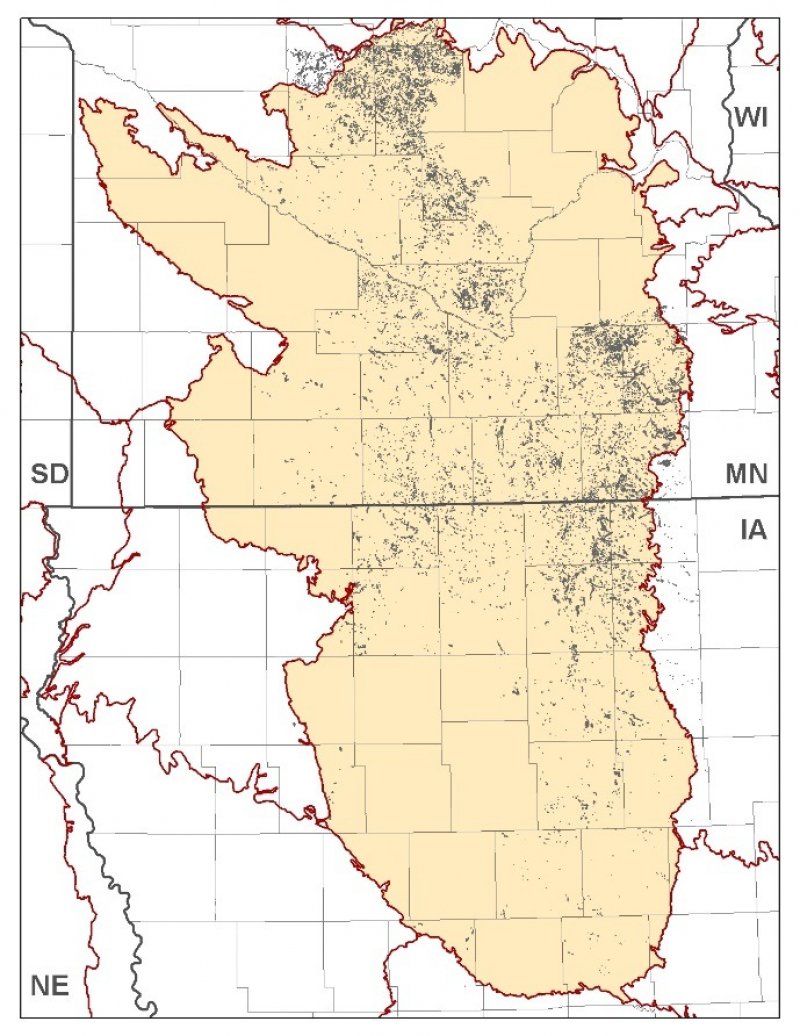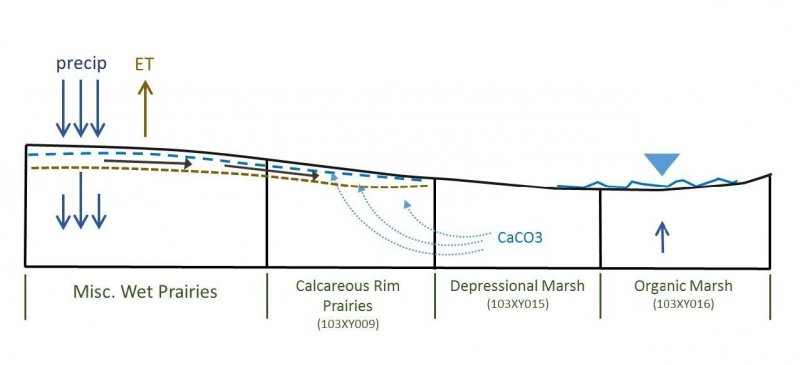
Natural Resources
Conservation Service
Ecological site R103XY016MN
Organic Marsh
Last updated: 10/04/2023
Accessed: 12/19/2025
General information
Provisional. A provisional ecological site description has undergone quality control and quality assurance review. It contains a working state and transition model and enough information to identify the ecological site.
MLRA notes
Major Land Resource Area (MLRA): 103X–Central Iowa and Minnesota Till Prairies
MLRA 103 is in Minnesota (56 percent) and Iowa (44 percent) and consists of approximately 18 million acres. It is in the Western Lake Section of the Central Lowland Province of the Interior Plains in an area known as the "Des Moines Lobe" of the Wisconsin-age ice sheet. The MLRA is mostly on a young, nearly level to gently rolling, glaciated till plain that has moraines and glacial lake plains in some areas. The plain is covered with glacial till, outwash, and glacial lake deposits. Recent alluvium consisting of clay, silt, sand, and gravel fill the bottoms of most of the major river valleys. Paleozoic bedrock sediments, primarily shale and limestone, underlie the glacial deposits in most of the area.
The annual precipitation increases from northwest to southeast. Most of the rainfall occurs as high-intensity, convective thunderstorms during the summer. Two-thirds or more of the precipitation falls during the freeze-free period. Snowfall is common in winter. Ground water supplies are adequate for the domestic, livestock, municipal, and industrial needs. Nearly all of this area is farmland, and about four-fifths is cropland.
Classification relationships
Major Land Resource Area (MLRA): Central Iowa and Minnesota Till Prairies (103) (USDA Handbook 296, 2006)
USFS Subregions: North Central Glaciated Plains Section (251B); Upper Minnesota River-Des Moines Lobe (251BA) and Southern Des Moines Lobe (251Be) Subsections (Cleland et al. 2007)
Relationship to Other Established Classifications:
The reference state shares similarities with Minnesota Department of Natural Resources MRp93-Prairie Bulrush-Arrowhead Marsh
Ecological site concept
The Organic Marsh ecological site is characterized by very poorly drained organic soils, a high water table, ponding, and hydrophytic vegetation.
Associated sites
| R103XY005MN |
Clayey Upland Prairies The Clayey Upland Prairies ecological site is located on uplands, including lakeplains, ground moraines, and till plains. Soils in this ecological site have a dark surface layer (mollic epipedon) and clayey textures. This site is not subject to flooding or ponding. Drainage class is somewhat poorly drained to well drained. |
|---|---|
| R103XY009MN |
Calcareous Rim Prairies The Calcareous Rim Prairies ecological site is characterized by landscape position (rim), calcareous soils, low slope (0-2%), and poorly drained soils. This site is hydrologically connected to adjacent ponded depressions. This site does not pond. |
| R103XY007MN |
Sandy Wet Prairies The Sandy Wet Prairies ecological site concept is areas on sandy, endosaturated soils located on outwash plains, valley trains, and glacial terraces associated with major river valleys. Soils contain sandy and gravelly outwash parent materials and often have a loamy mantle of 20 to 40 inches deep. Drainage class is poorly drained. |
| R103XY008MN |
Clayey Wet Prairies The Clayey Wet Prairie ecological site occurs predominately on till plains and glacial lake plains, particularly in the Glacial Lake Minnesota area. This site is characterized by soils that have a clayey texture and are poorly drained. These soils developed under prairie vegetation and have dark colored surface horizons. Common soil surface textures include clay, silty clay, and silty clay loam. This site is generally not ponded but has an inherent water table (i.e. endosaturated) and can have slow surface infiltration, causing seasonal perching. |
| R103XY022MN |
Loamy Wet Savannas The Loamy Wet Savannas ecological site is located on soils that are derived from fine loamy till. Soils are classified as poorly drained. This site occurs on morainal ridges or in slight concavities and linear segments with a slope of less than 2 percent. |
Similar sites
| R103XY015MN |
Depressional Marsh The Depressional Marsh ecological site is in concave small- to medium-sized depressions. This site is very poorly drained and ponded throughout the early part of the growing season in most years (i.e. seasonal wetlands). Vegetation includes cattails, bulrushes, sedges and other emergent wetland species. |
|---|
Table 1. Dominant plant species
| Tree |
Not specified |
|---|---|
| Shrub |
Not specified |
| Herbaceous |
(1) Schoenoplectus tabernaemontani |
Click on box and path labels to scroll to the respective text.
Ecosystem states
| T1A | - | Disturbances such as hydrological modifications, cattle grazing, invasive species |
|---|---|---|
| R2A | - | Management inputs to restore natural functions of the site |


